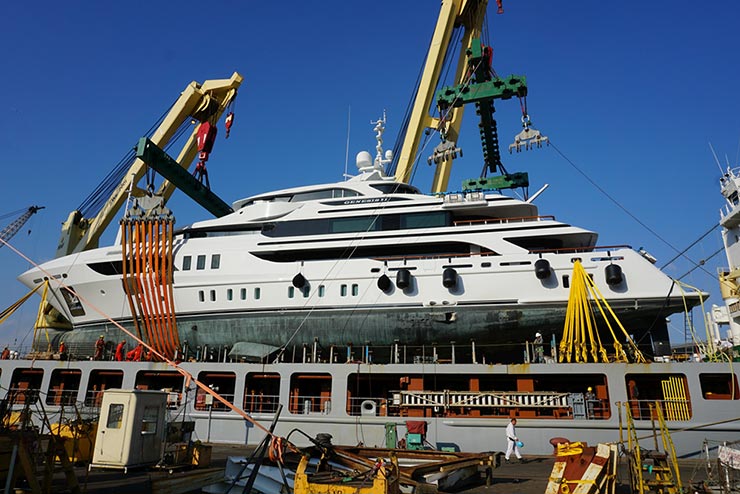
Silver Lining (left) is ready to hit the water while Chasseur will be completed by early autumn. Building fundamentally similar designs in adjacent bays is one reason for construction efficiency, enabling Christensen to launch dozens of megayachts over the years.

The yard’s design is a model for efficient fabrication with various construction departments close by each boat project, which rises to a topside area for deck tooling and offices for captains and project managers that are a few yards off the stern of each yacht.

The general length, beam and draught of the two yachts are similar, nearing the maximum size that can be built in this facility. Yet subtle design features, bulwarks, deck configuration, interior, and propulsion produce very different styles for very different owners.

Christensen Yachts has had a design formula that has continuously adapted and appealed to buyers. Decks are teak with stainless rails upon solid bulwarks and defined by rakish fashion plates. The third deck offers either helm station or hot tub area topside and spacious settee on the fore deck.

The larger and more rigid the sections of the yacht, the greater the strength and integrity of the entire bond of hull, deck and superstructure. The deck section shown is ready for placement on one of the projects down the line.

One of Christensen’s recent designs’ most liveable features is the sprawling foredeck seating area on the main deck that provides an ideal perch underway. Here it is near completion with cardboard protecting the teak deck and fibreglass areas.

Prop pockets have long helped develop a shallower draught design along with recessed zinc anodes, underwater exhaust and maximum-effect twin rudders aft of each prop. These props are coated with a shiny slick application of Propspeed, a product designed to reduce growth.

Silver Lining, a 49-meter (160ft) composite design, is ready to go with only the launching procedure to follow. The stainless anchor guard, sleek stem and bulbous bow dominate the entry look with the bulb reducing drag, increasing buoyancy and increasing speed up to a knot over the great oceanic distances.

The composite construction involves coring materials, stiffeners and a complicated laminate schedule customised for each shape of the boat, different thicknesses, adhesives, and materials. Vacuum bagging is a simple but effective way to produce consistent pressure for maximum adhesion with minimum resin to reduce weight and excess materials.

In one of more than a half a dozen similar construction bays, this cored composite hull is having bulkheads placed and awaits progress in an almost assembly line hull construction.

Workers in slick high places, such as the glossy brow of this yacht, are tethered to prevent falls and most of their tools have lanyards to prevent dropping items on the deck below. At any moment, fibreglass workers, electricians, plumbers, carpenters, metal workers, and upholsterers all converge on the project at once as they near launch.

Inverted tooling pieces sit in the foreground as this hull is getting fitted with longitudinal stiffeners at its midsection while the superstructure is in the early stages of erecting house sides.

Foam cored stiffeners will be glassed over to form a rigid composite structure while this worker is sanding the edges prior to lamination. Fibreglass dominates megayacht construction of about 50m (175ft) and under, but beyond those lengths the composite techniques often give way to steel and alloy fabrication.

Lights, camera, action! Why not? The open orifice in this bulbous bow will fit lights and a camera to make underwater exploration a truly practical application when entering unknown waters or simply to enjoy the view of reefs and undersea life normally hidden from view.

This is a production yard, but each boat is a custom project beyond the fundamentals. Plan updates and engineering drawings are constantly posted for builders to take note. The yard is again ramping up with 120 workers now, still quite some way from its one-time high point of 400-plus.

A full yard provides all the custom in-house fabrication necessary, and stonework has become an important interior and exterior design element. Some stonework is designed with cored backing to lighten the load.




